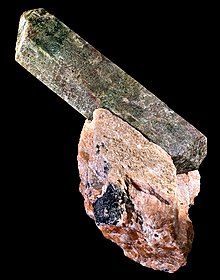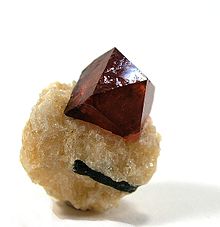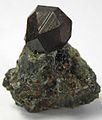Portal:Minerals
Portal maintenance status: (May 2019)
|
The Minerals Portal

In geology and mineralogy, a mineral or mineral species is, broadly speaking, a solid substance with a fairly well-defined chemical composition and a specific crystal structure that occurs naturally in pure form.
The geological definition of mineral normally excludes compounds that occur only in living organisms. However, some minerals are often biogenic (such as calcite) or organic compounds in the sense of chemistry (such as mellite). Moreover, living organisms often synthesize inorganic minerals (such as hydroxylapatite) that also occur in rocks.
The concept of mineral is distinct from rock, which is any bulk solid geologic material that is relatively homogeneous at a large enough scale. A rock may consist of one type of mineral or may be an aggregate of two or more different types of minerals, spacially segregated into distinct phases.
Some natural solid substances without a definite crystalline structure, such as opal or obsidian, are more properly called mineraloids. If a chemical compound occurs naturally with different crystal structures, each structure is considered a different mineral species. Thus, for example, quartz and stishovite are two different minerals consisting of the same compound, silicon dioxide. (Full article...)
Mineralogy is a subject of geology specializing in the scientific study of the chemistry, crystal structure, and physical (including optical) properties of minerals and mineralized artifacts. Specific studies within mineralogy include the processes of mineral origin and formation, classification of minerals, their geographical distribution, as well as their utilization. (Full article...)
Selected articles
-
Image 1

Zeolite exhibited in the Estonian Museum of Natural History
Zeolite is a family of several microporous, crystalline aluminosilicate materials commonly used as commercial adsorbents and catalysts. They mainly consist of silicon, aluminium, oxygen, and have the general formula Mn+
1/n(AlO
2)−
(SiO
2)
x・yH
2O where Mn+
1/n is either a metal ion or H+.
The term was originally coined in 1756 by Swedish mineralogist Axel Fredrik Cronstedt, who observed that rapidly heating a material, believed to have been stilbite, produced large amounts of steam from water that had been adsorbed by the material. Based on this, he called the material zeolite, from the Greek ζέω (zéō), meaning "to boil" and λίθος (líthos), meaning "stone".
Zeolites occur naturally, but are also produced industrially on a large scale. As of December 2018[update], 253 unique zeolite frameworks have been identified, and over 40 naturally occurring zeolite frameworks are known. Every new zeolite structure that is obtained is examined by the International Zeolite Association Structure Commission (IZA-SC) and receives a three-letter designation. (Full article...) -
Image 2
A rock containing three crystals of pyrite (FeS2). The crystal structure of pyrite is primitive cubic, and this is reflected in the cubic symmetry of its natural crystal facets.
In crystallography, the cubic (or isometric) crystal system is a crystal system where the unit cell is in the shape of a cube. This is one of the most common and simplest shapes found in crystals and minerals.
There are three main varieties of these crystals:- Primitive cubic (abbreviated cP and alternatively called simple cubic)
- Body-centered cubic (abbreviated cI or bcc)
- Face-centered cubic (abbreviated cF or fcc)
Note: the term fcc is often used in synonym for the cubic close-packed or ccp structure occurring in metals. However, fcc stands for a face-centered-cubic Bravais lattice, which is not necessarily close-packed when a motif is set onto the lattice points. E.g. the diamond and the zincblende lattices are fcc but not close-packed.
Each is subdivided into other variants listed below. Although the unit cells in these crystals are conventionally taken to be cubes, the primitive unit cells often are not. (Full article...) -
Image 3Galena with minor pyrite
Galena, also called lead glance, is the natural mineral form of lead(II) sulfide (PbS). It is the most important ore of lead and an important source of silver.
Galena is one of the most abundant and widely distributed sulfide minerals. It crystallizes in the cubic crystal system often showing octahedral forms. It is often associated with the minerals sphalerite, calcite and fluorite. (Full article...) -
Image 4Beachy Head is a part of the extensive Southern England Chalk Formation.
Chalk is a soft, white, porous, sedimentary carbonate rock. It is a form of limestone composed of the mineral calcite and originally formed deep under the sea by the compression of microscopic plankton that had settled to the sea floor. Chalk is common throughout Western Europe, where deposits underlie parts of France, and steep cliffs are often seen where they meet the sea in places such as the Dover cliffs on the Kent coast of the English Channel.
Chalk is mined for use in industry, such as for quicklime, bricks and builder's putty, and in agriculture, for raising pH in soils with high acidity. It is also used for "blackboard chalk" for writing and drawing on various types of surfaces, although these can also be manufactured from other carbonate-based minerals, or gypsum. (Full article...) -
Image 5Malachite from the Democratic Republic of the Congo
Malachite is a copper carbonate hydroxide mineral, with the formula Cu2CO3(OH)2. This opaque, green-banded mineral crystallizes in the monoclinic crystal system, and most often forms botryoidal, fibrous, or stalagmitic masses, in fractures and deep, underground spaces, where the water table and hydrothermal fluids provide the means for chemical precipitation. Individual crystals are rare, but occur as slender to acicular prisms. Pseudomorphs after more tabular or blocky azurite crystals also occur. (Full article...) -
Image 6
Graphite (/ˈɡræfaɪt/) is a crystalline allotrope (form) of the element carbon. It consists of many stacked layers of graphene, typically in the excess of hundreds of layers. Graphite occurs naturally and is the most stable form of carbon under standard conditions. Synthetic and natural graphite are consumed on a large scale (1.3 million metric tons per year in 2022) for uses in many critical industries including refractories (50%), lithium-ion batteries (18%), foundries (10%), lubricants (5%), among others (17%). Under extremely high pressures and extremely high temperatures it converts to diamond. Graphite's low cost, thermal and chemical inertness and characteristic conductivity of heat and electricity finds numerous applications in high energy and high temperature processes. (Full article...) -
Image 7Brazilian trigonal hematite crystal
Hematite (/ˈhiːməˌtaɪt, ˈhɛmə-/), also spelled as haematite, is a common iron oxide compound with the formula, Fe2O3 and is widely found in rocks and soils. Hematite crystals belong to the rhombohedral lattice system which is designated the alpha polymorph of Fe
2O
3. It has the same crystal structure as corundum (Al
2O
3) and ilmenite (FeTiO
3). With this it forms a complete solid solution at temperatures above 950 °C (1,740 °F).
Hematite occurs naturally in black to steel or silver-gray, brown to reddish-brown, or red colors. It is mined as an important ore mineral of iron. It is electrically conductive. Hematite varieties include kidney ore, martite (pseudomorphs after magnetite), iron rose and specularite (specular hematite). While these forms vary, they all have a rust-red streak. Hematite is not only harder than pure iron, but also much more brittle. Maghemite is a polymorph of hematite (γ-Fe
2O
3) with the same chemical formula, but with a spinel structure like magnetite.
Large deposits of hematite are found in banded iron formations. Gray hematite is typically found in places that have still, standing water, or mineral hot springs, such as those in Yellowstone National Park in North America. The mineral may precipitate in the water and collect in layers at the bottom of the lake, spring, or other standing water. Hematite can also occur in the absence of water, usually as the result of volcanic activity.
Clay-sized hematite crystals also may occur as a secondary mineral formed by weathering processes in soil, and along with other iron oxides or oxyhydroxides such as goethite, which is responsible for the red color of many tropical, ancient, or otherwise highly weathered soils. (Full article...) -
Image 8
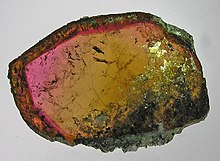
Tourmaline (/ˈtʊərməlɪn, -ˌliːn/ TOOR-mə-lin, -leen) is a crystalline silicate mineral group in which boron is compounded with elements such as aluminium, iron, magnesium, sodium, lithium, or potassium. This gemstone comes in a wide variety of colors.
The name is derived from the Sinhalese tōramalli (ටෝරමල්ලි), which refers to the carnelian gemstones. (Full article...) -
Image 9
Apatite is a group of phosphate minerals, usually hydroxyapatite, fluorapatite and chlorapatite, with high concentrations of OH−, F− and Cl− ion, respectively, in the crystal. The formula of the admixture of the three most common endmembers is written as Ca10(PO4)6(OH,F,Cl)2, and the crystal unit cell formulae of the individual minerals are written as Ca10(PO4)6(OH)2, Ca10(PO4)6F2 and Ca10(PO4)6Cl2.
The mineral was named apatite by the German geologist Abraham Gottlob Werner in 1786, although the specific mineral he had described was reclassified as fluorapatite in 1860 by the German mineralogist Karl Friedrich August Rammelsberg. Apatite is often mistaken for other minerals. This tendency is reflected in the mineral's name, which is derived from the Greek word ἀπατάω (apatáō), which means to deceive. (Full article...) -
Image 10
The mineral pyrite (/ˈpaɪraɪt/ PY-ryte), or iron pyrite, also known as fool's gold, is an iron sulfide with the chemical formula FeS2 (iron (II) disulfide). Pyrite is the most abundant sulfide mineral.
Pyrite's metallic luster and pale brass-yellow hue give it a superficial resemblance to gold, hence the well-known nickname of fool's gold. The color has also led to the nicknames brass, brazzle, and brazil, primarily used to refer to pyrite found in coal.
The name pyrite is derived from the Greek πυρίτης λίθος (pyritēs lithos), 'stone or mineral which strikes fire', in turn from πῦρ (pŷr), 'fire'. In ancient Roman times, this name was applied to several types of stone that would create sparks when struck against steel; Pliny the Elder described one of them as being brassy, almost certainly a reference to what is now called pyrite.
By Georgius Agricola's time, c. 1550, the term had become a generic term for all of the sulfide minerals. (Full article...) -
Image 11A sample of andesite (dark groundmass) with amygdaloidal vesicles filled with zeolite. Diameter of view is 8 cm.
Andesite (/ˈændəzaɪt/) is a volcanic rock of intermediate composition. In a general sense, it is the intermediate type between silica-poor basalt and silica-rich rhyolite. It is fine-grained (aphanitic) to porphyritic in texture, and is composed predominantly of sodium-rich plagioclase plus pyroxene or hornblende.
Andesite is the extrusive equivalent of plutonic diorite. Characteristic of subduction zones, andesite represents the dominant rock type in island arcs. The average composition of the continental crust is andesitic. Along with basalts, andesites are a component of the Martian crust.
The name andesite is derived from the Andes mountain range, where this rock type is found in abundance. It was first applied by Christian Leopold von Buch in 1826. (Full article...) -
Image 12
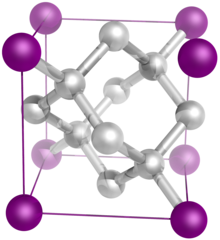
The diamond crystal structure belongs to the face-centered cubic lattice, with a repeated two-atom pattern.
In crystallography, a crystal system is a set of point groups (a group of geometric symmetries with at least one fixed point). A lattice system is a set of Bravais lattices. Space groups are classified into crystal systems according to their point groups, and into lattice systems according to their Bravais lattices. Crystal systems that have space groups assigned to a common lattice system are combined into a crystal family.
The seven crystal systems are triclinic, monoclinic, orthorhombic, tetragonal, trigonal, hexagonal, and cubic. Informally, two crystals are in the same crystal system if they have similar symmetries (though there are many exceptions). (Full article...) -
Image 13

A crystalline solid: atomic resolution image of strontium titanate. Brighter spots are columns of strontium atoms and darker ones are titanium-oxygen columns.
Crystallography is the branch of science devoted to the study of molecular and crystalline structure and properties. The word crystallography is derived from the Ancient Greek word κρύσταλλος (krústallos; "clear ice, rock-crystal"), and γράφειν (gráphein; "to write"). In July 2012, the United Nations recognised the importance of the science of crystallography by proclaiming 2014 the International Year of Crystallography.
Crystallography is a broad topic, and many of its subareas, such as X-ray crystallography, are themselves important scientific topics. Crystallography ranges from the fundamentals of crystal structure to the mathematics of crystal geometry, including those that are not periodic or quasicrystals. At the atomic scale it can involve the use of X-ray diffraction to produce experimental data that the tools of X-ray crystallography can convert into detailed positions of atoms, and sometimes electron density. At larger scales it includes experimental tools such as orientational imaging to examine the relative orientations at the grain boundary in materials. Crystallography plays a key role in many areas of biology, chemistry, and physics, as well new developments in these fields. (Full article...) -
Image 14A lustrous crystal of zircon perched on a tan matrix of calcite from the Gilgit District of Pakistan
Zircon (/ˈzɜːrkɒn, -kən/) is a mineral belonging to the group of nesosilicates and is a source of the metal zirconium. Its chemical name is zirconium(IV) silicate, and its corresponding chemical formula is ZrSiO4. An empirical formula showing some of the range of substitution in zircon is (Zr1–y, REEy)(SiO4)1–x(OH)4x–y. Zircon precipitates from silicate melts and has relatively high concentrations of high field strength incompatible elements. For example, hafnium is almost always present in quantities ranging from 1 to 4%. The crystal structure of zircon is tetragonal crystal system. The natural color of zircon varies between colorless, yellow-golden, red, brown, blue, and green.
The name derives from the Persian zargun, meaning "gold-hued". This word is changed into "jargoon", a term applied to light-colored zircons. The English word "zircon" is derived from Zirkon, which is the German adaptation of this word. Yellow, orange, and red zircon is also known as "hyacinth", from the flower hyacinthus, whose name is of Ancient Greek origin. (Full article...) -
Image 15A ruby crystal from Dodoma Region, Tanzania
Ruby is a pinkish red to blood-red colored gemstone, a variety of the mineral corundum (aluminium oxide). Ruby is one of the most popular traditional jewelry gems and is very durable. Other varieties of gem-quality corundum are called sapphires. Ruby is one of the traditional cardinal gems, alongside amethyst, sapphire, emerald, and diamond. The word ruby comes from ruber, Latin for red. The color of a ruby is due to the element chromium.
Some gemstones that are popularly or historically called rubies, such as the Black Prince's Ruby in the British Imperial State Crown, are actually spinels. These were once known as "Balas rubies".
The quality of a ruby is determined by its color, cut, and clarity, which, along with carat weight, affect its value. The brightest and most valuable shade of red, called blood-red or pigeon blood, commands a large premium over other rubies of similar quality. After color follows clarity: similar to diamonds, a clear stone will command a premium, but a ruby without any needle-like rutile inclusions may indicate that the stone has been treated. Ruby is the traditional birthstone for July and is usually pinker than garnet, although some rhodolite garnets have a similar pinkish hue to most rubies. The world's most valuable ruby to be sold at auction is the Sunrise Ruby, which sold for US$34.8 million. (Full article...) -
Image 16
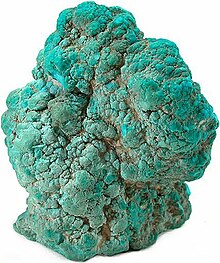
Turquoise is an opaque, blue-to-green mineral that is a hydrous phosphate of copper and aluminium, with the chemical formula CuAl6(PO4)4(OH)8·4H2O. It is rare and valuable in finer grades and has been prized as a gemstone for millennia due to its hue.
Like most other opaque gems, turquoise has been devalued by the introduction of treatments, imitations, and synthetics into the market. The robin egg blue or sky blue color of the Persian turquoise mined near the modern city of Nishapur, Iran, has been used as a guiding reference for evaluating turquoise quality. (Full article...) -
Image 17

Crystal structure of table salt (sodium in purple, chlorine in green)
In crystallography, crystal structure is a description of ordered arrangement of atoms, ions, or molecules in a crystalline material. Ordered structures occur from intrinsic nature of constituent particles to form symmetric patterns that repeat along the principal directions of three-dimensional space in matter.
The smallest group of particles in material that constitutes this repeating pattern is unit cell of the structure. The unit cell completely reflects symmetry and structure of the entire crystal, which is built up by repetitive translation of unit cell along its principal axes. The translation vectors define the nodes of Bravais lattice.
The lengths of principal axes/edges, of unit cell and angles between them are lattice constants, also called lattice parameters or cell parameters. The symmetry properties of crystal are described by the concept of space groups. All possible symmetric arrangements of particles in three-dimensional space may be described by 230 space groups.
The crystal structure and symmetry play a critical role in determining many physical properties, such as cleavage, electronic band structure, and optical transparency. (Full article...) -
Image 18
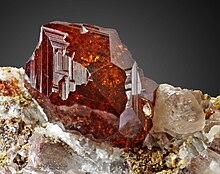
Garnets ( /ˈɡɑːrnɪt/) are a group of silicate minerals that have been used since the Bronze Age as gemstones and abrasives.
All species of garnets possess similar physical properties and crystal forms, but differ in chemical composition. The different species are pyrope, almandine, spessartine, grossular (varieties of which are hessonite or cinnamon-stone and tsavorite), uvarovite and andradite. The garnets make up two solid solution series: pyrope-almandine-spessartine (pyralspite), with the composition range [Mg,Fe,Mn]3Al2(SiO4)3; and uvarovite-grossular-andradite (ugrandite), with the composition range Ca3[Cr,Al,Fe]2(SiO4)3. (Full article...) -
Image 19
Diamond is a solid form of the element carbon with its atoms arranged in a crystal structure called diamond cubic. Diamond as a form of carbon is a tasteless, odourless, strong, brittle solid, colourless in pure form, a poor conductor of electricity, and insoluble in water. Another solid form of carbon known as graphite is the chemically stable form of carbon at room temperature and pressure, but diamond is metastable and converts to it at a negligible rate under those conditions. Diamond has the highest hardness and thermal conductivity of any natural material, properties that are used in major industrial applications such as cutting and polishing tools. They are also the reason that diamond anvil cells can subject materials to pressures found deep in the Earth.
Because the arrangement of atoms in diamond is extremely rigid, few types of impurity can contaminate it (two exceptions are boron and nitrogen). Small numbers of defects or impurities (about one per million of lattice atoms) can color a diamond blue (boron), yellow (nitrogen), brown (defects), green (radiation exposure), purple, pink, orange, or red. Diamond also has a very high refractive index and a relatively high optical dispersion.
Most natural diamonds have ages between 1 billion and 3.5 billion years. Most were formed at depths between 150 and 250 kilometres (93 and 155 mi) in the Earth's mantle, although a few have come from as deep as 800 kilometres (500 mi). Under high pressure and temperature, carbon-containing fluids dissolved various minerals and replaced them with diamonds. Much more recently (hundreds to tens of million years ago), they were carried to the surface in volcanic eruptions and deposited in igneous rocks known as kimberlites and lamproites.
Synthetic diamonds can be grown from high-purity carbon under high pressures and temperatures or from hydrocarbon gases by chemical vapor deposition (CVD). Imitation diamonds can also be made out of materials such as cubic zirconia and silicon carbide. Natural, synthetic, and imitation diamonds are most commonly distinguished using optical techniques or thermal conductivity measurements. (Full article...) -
Image 20

Talc, or talcum, is a clay mineral composed of hydrated magnesium silicate, with the chemical formula Mg3Si4O10(OH)2. Talc in powdered form, often combined with corn starch, is used as baby powder. This mineral is used as a thickening agent and lubricant. It is an ingredient in ceramics, paints, and roofing material. It is a main ingredient in many cosmetics. It occurs as foliated to fibrous masses, and in an exceptionally rare crystal form. It has a perfect basal cleavage and an uneven flat fracture, and it is foliated with a two-dimensional platy form.
The Mohs scale of mineral hardness, based on scratch hardness comparison, defines value 1 as the hardness of talc, the softest mineral. When scraped on a streak plate, talc produces a white streak, though this indicator is of little importance, because most silicate minerals produce a white streak. Talc is translucent to opaque, with colors ranging from whitish grey to green with a vitreous and pearly luster. Talc is not soluble in water, and is slightly soluble in dilute mineral acids.
Soapstone is a metamorphic rock composed predominantly of talc. (Full article...) -
Image 21
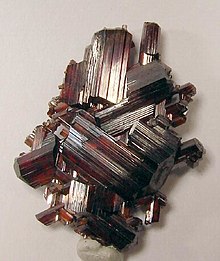
Rutile is an oxide mineral composed of titanium dioxide (TiO2), the most common natural form of TiO2. Rarer polymorphs of TiO2 are known, including anatase, akaogiite, and brookite.
Rutile has one of the highest refractive indices at visible wavelengths of any known crystal and also exhibits a particularly large birefringence and high dispersion. Owing to these properties, it is useful for the manufacture of certain optical elements, especially polarization optics, for longer visible and infrared wavelengths up to about 4.5 micrometres. Natural rutile may contain up to 10% iron and significant amounts of niobium and tantalum.
Rutile derives its name from the Latin rutilus ('red'), in reference to the deep red color observed in some specimens when viewed by transmitted light. Rutile was first described in 1803 by Abraham Gottlob Werner using specimens obtained in Horcajuelo de la Sierra, Madrid (Spain), which is consequently the type locality. (Full article...) -
Image 22
Asbestos (/æsˈbɛstəs, æz-, -tɒs/ ass-BES-təs, az-, -toss) is a naturally occurring, carcinogenic, fibrous silicate mineral. There are six types, all of which are composed of long and thin fibrous crystals, each fibre (particulate with length substantially greater than width) being composed of many microscopic "fibrils" that can be released into the atmosphere by abrasion and other processes. Inhalation of asbestos fibres can lead to various dangerous lung conditions, including mesothelioma, asbestosis, and lung cancer. As a result of these health effects, asbestos is considered a serious health and safety hazard.
Archaeological studies have found evidence of asbestos being used as far back as the Stone Age to strengthen ceramic pots, but large-scale mining began at the end of the 19th century when manufacturers and builders began using asbestos for its desirable physical properties. Asbestos is an excellent thermal and electrical insulator, and is highly fire resistant, so for much of the 20th century, it was very commonly used around the world as a building material (particularly for its fire-retardant properties), until its adverse effects on human health were more widely recognized and acknowledged in the 1970s. Many buildings constructed before the 1980s contain asbestos.
The use of asbestos for construction and fireproofing has been made illegal in many countries. Despite this, around 255,000 people are thought to die each year from diseases related to asbestos exposure. In part, this is because many older buildings still contain asbestos; in addition, the consequences of exposure can take decades to arise. The latency period (from exposure until the diagnosis of negative health effects) is typically 20 years. The most common diseases associated with chronic asbestos exposure are asbestosis (scarring of the lungs due to asbestos inhalation) and mesothelioma (a type of cancer).
Many developing countries still support the use of asbestos as a building material, and mining of asbestos is ongoing, with the top producer, Russia, having an estimated production of 790,000 tonnes in 2020. (Full article...) -
Image 23Dolomite (white) on talc
Dolomite (/ˈdɒl.əˌmaɪt, ˈdoʊ.lə-/) is an anhydrous carbonate mineral composed of calcium magnesium carbonate, ideally CaMg(CO3)2. The term is also used for a sedimentary carbonate rock composed mostly of the mineral dolomite (see Dolomite (rock)). An alternative name sometimes used for the dolomitic rock type is dolostone. (Full article...) -
Image 24

Green fluorite with prominent cleavage
Cleavage, in mineralogy and materials science, is the tendency of crystalline materials to split along definite crystallographic structural planes. These planes of relative weakness are a result of the regular locations of atoms and ions in the crystal, which create smooth repeating surfaces that are visible both in the microscope and to the naked eye. If bonds in certain directions are weaker than others, the crystal will tend to split along the weakly bonded planes. These flat breaks are termed "cleavage". The classic example of cleavage is mica, which cleaves in a single direction along the basal pinacoid, making the layers seem like pages in a book. In fact, mineralogists often refer to "books of mica".
Diamond and graphite provide examples of cleavage. Each is composed solely of a single element, carbon. In diamond, each carbon atom is bonded to four others in a tetrahedral pattern with short covalent bonds. The planes of weakness (cleavage planes) in a diamond are in four directions, following the faces of the octahedron. In graphite, carbon atoms are contained in layers in a hexagonal pattern where the covalent bonds are shorter (and thus even stronger) than those of diamond. However, each layer is connected to the other with a longer and much weaker van der Waals bond. This gives graphite a single direction of cleavage, parallel to the basal pinacoid. So weak is this bond that it is broken with little force, giving graphite a slippery feel as layers shear apart. As a result, graphite makes an excellent dry lubricant.
While all single crystals will show some tendency to split along atomic planes in their crystal structure, if the differences between one direction or another are not large enough, the mineral will not display cleavage. Corundum, for example, displays no cleavage. (Full article...) -
Image 25

Corundum is a crystalline form of aluminium oxide (Al2O3) typically containing traces of iron, titanium, vanadium, and chromium. It is a rock-forming mineral. It is a naturally transparent material, but can have different colors depending on the presence of transition metal impurities in its crystalline structure. Corundum has two primary gem varieties: ruby and sapphire. Rubies are red due to the presence of chromium, and sapphires exhibit a range of colors depending on what transition metal is present. A rare type of sapphire, padparadscha sapphire, is pink-orange.
The name "corundum" is derived from the Tamil-Dravidian word kurundam (ruby-sapphire) (appearing in Sanskrit as kuruvinda).
Because of corundum's hardness (pure corundum is defined to have 9.0 on the Mohs scale), it can scratch almost all other minerals. It is commonly used as an abrasive on sandpaper and on large tools used in machining metals, plastics, and wood. Emery, a variety of corundum with no value as a gemstone, is commonly used as an abrasive. It is a black granular form of corundum, in which the mineral is intimately mixed with magnetite, hematite, or hercynite.
In addition to its hardness, corundum has a density of 4.02 g/cm3 (251 lb/cu ft), which is unusually high for a transparent mineral composed of the low-atomic mass elements aluminium and oxygen. (Full article...)
Selected mineralogist
-
Image 1François Michel de Rozière (29 September 1775, Melun – 4 November 1842, Melun) was a French mining engineer and mineralogist. (Full article...)
-
Image 2

Jens Esmark
Jens Esmark (31 January 1763 – 26 January 1839) was a Danish-Norwegian professor of mineralogy who contributed to many of the initial discoveries and conceptual analyses of glaciers, specifically the concept that glaciers had covered larger areas in the past. (Full article...) -
Image 3Frank Thomas Matthews White (1909–1971) was an Australian mining and metallurgical engineer and mineral science educator. His career included appointments in Australia, Fiji, Malaya, and Canada.
An examination of White's career reveals steady progression from an initial technical focus on the goldfields of Western Australia, to the challenge of new mining enterprises in Fiji and the post-war rehabilitation of tin mining in Malaya. He applied these insights in developing academic programs at the University of Queensland and at McGill University, referring to the spectrum as "the total environment of mining". To pursue this vision at McGill, in 1968 he initiated an Institute for Mineral Industry Research. Two buildings, including a geodesic dome, were constructed to house the institute at the mineral-rich Gault Estate in Mont-Saint-Hilaire, Quebec, where ventilation research and simulations were conducted. This initiative came to an end due to his untimely death; his ashes were scattered at the site, and a commemorative cairn erected. Momentum from the initiative contributed to the formation in 1974 of an Institute of Occupational Health and Safety at McGill. A monument in his honor, donated by former students, is in place at the Experimental Mine, University of Queensland. His life story is the subject of a biography entitled Miner with a Heart of Gold. (Full article...) -
Image 4Hendrik Enno Boeke (12 September 1881, in Wormerveer – 6 December 1918, in Frankfurt am Main) was a Dutch mineralogist and petrographer.
From 1900 he studied chemistry and physics at the University of Amsterdam, where his instructors included Hendrik Willem Bakhuis Roozeboom and Johannes Diderik van der Waals. He then worked as an assistant under Gustav Tammann in Göttingen and to Friedrich Rinne at the Technical University of Hannover. In 1909 he became a lecturer of chemistry at the University of Königsberg, and during the following year, an associate professor of physical-chemical mineralogy and petrology at the University of Leipzig. (Full article...) -
Image 5Pierre Bernard Palassou (9 June 1745, Oloron-Sainte-Marie – 9 April 1830, Ogenne-Camptort) was a French naturalist known for pioneer geological and mineralogical studies of the Pyrénées.
He was a correspondent member of the Académie des sciences (1816–1830) and an honorary member of the Société linnéenne de Paris (1821). His name is associated with the "Poudingues de Palassou", which are enormous beds of conglomerate rock found in the Pyrénées. In 1784 he described Quercus palensis (Pyrenean oak) of the botanical family Fagaceae, (synonym Quercus pyrenaica Willd.). (Full article...) -
Image 6
James De Carle Sowerby (5 June 1787 – 26 August 1871) was a British mineralogist, botanist, and illustrator. He received an education in chemistry.
Sowerby was born in London, the son of botanical artist James Sowerby (1757–1822), and his wife, Anne de Carle (1764–1815). He continued his father's work and published, together with his brother George Brettingham Sowerby I, the latter volumes of the Mineral Conchology of Great Britain, begun by their father. (Full article...) -
Image 7Adolarius Jacob Forster (1739–1806) was a Prussian mineralogist and dealer in display specimen minerals. The Forster family left Yorkshire in 1649 and settled in Prussia. Adolarius Jacob Forster began dealing in mineral specimens around 1766, at the age of 27. He continued in that profession for 40 years and travelled widely. He had premises in London, Paris and St. Petersburg. The Covent Garden, London shop and one in Soho was run by his wife. His brother, Ingham Henry Forster (1725–1782) ran the business in Paris. Auction catalogues for sales in Paris were written by Romé de l'Isle.
He was related to Johann Georg Adam Forster and Johann Reinhold Forster and his sister married the London dealer naturalist George Humphrey at St-Martin-in-the-Fields, London on August 16, 1768. In 1802 Forster sold a collection to the museum of the St Petersburg Mining Institute, under the auspices of the Emperor of All Russia Alexander I. He spent the last ten years of his life in Russia, and died in St. Petersburg in 1806. The dealership was taken over by his nephew John Henry Heuland. (Full article...) -
Image 8David Forbes FRS (6 September 1828 – 5 December 1876) was a Manx mineralogist, metallurgist, and chemist. (Full article...)
-
Image 9Carl Adolf Ferdinand Hintze (17 August 1851, Breslau – 28 December 1916, Breslau) was a German mineralogist and crystallographer.
From 1868 he studied at the University of Breslau, where he was a student of Ferdinand von Roemer. He then furthered his education at the universities of Bonn and Berlin. Beginning in 1872 he served as an assistant to mineralogist Paul Heinrich von Groth at the University of Strasbourg. In 1875, eye problems along with financial issues forced him to abandon his scientific activity at the university, and he subsequently found employment as a trader in the minerals business. Since 1880 he worked as a scientific director for a private firm in Bonn. (Full article...) -
Image 10

Ernst Friedrich Germar
Ernst Friedrich Germar (3 November 1786 – 8 July 1853) was a German professor and director of the Mineralogical Museum at Halle. As well as being a mineralogist he was interested in entomology and particularly in the Coleoptera and Hemiptera. He wrote monographs on several insect families including the Scutelleridae. He also took an interest in paleoentomology. (Full article...) -
Image 11William Sefton Fyfe, CC FRSC FRS FRSNZ (4 June 1927 – 11 November 2013) was a New Zealand geologist and Professor Emeritus in the department of Earth Sciences at the University of Western Ontario. He is widely considered among the world's most eminent geochemists. (Full article...)
-
Image 12Peter John Wyllie (born 8 February 1930, in London, England) is a British petrologist and academic.
He was Professor of Geology at the California Institute of Technology from 1983 until his retirement in 1999. Prior to this, he held positions at the University of St Andrews (1955–56), Pennsylvania State University (1958–59 and 1961–66), the University of Leeds (1959–61), and the University of Chicago (1965–83). He is well known for his many contributions to the understanding of magmatism, particularly through his work on the experimental petrology of magmas and volatiles. In the early 1970s, Wyllie wrote two widely used textbooks; The Dynamic Earth (1971) and The Way the Earth Works (1976) which integrated the new understanding of magmatism and plate tectonics. He is also famous for his contributions to the coverage of earth sciences in the Encyclopædia Britannica, particularly his outline of the field in Part Two of the Propædia. Wyllie was President of the International Union of Geodesy and Geophysics (IUGG) from 1995 to 1999. (Full article...) -
Image 13
Johann Friedrich August Breithaupt (May 16, 1791 – September 22, 1873) was a German mineralogist and professor at Freiberg Mining Academy in Freiberg, Saxony. (Full article...) -
Image 14Aristides Brezina (4 May 1848 – 25 May 1909) was an Austrian mineralogist born in Vienna.
In 1872 he graduated from the University of Tübingen, and afterwards taught crystallography at the University of Vienna. In 1878 he succeeded Austrian mineralogist Gustav Tschermak (1836-1927) as custodian of the meteorite collection at Vienna, and from 1889 until 1896 he was director of the Mineralogisch-Petrographische Abteilung (Department of Mineralogy-Petrography). In 1886, he was elected as a member to the American Philosophical Society. (Full article...) -
Image 15

Karl August Lossen
Karl August Lossen (born Kreuznach (Rhineland), 5 January 1841; died Berlin, 24 February 1893) was a German petrologist and geologist.
After finishing his studies at the gymnasium of Kreuznach in 1859 Lossen became a mining engineer; he began by two and a half years of practical work, then studied at the Universities of Berlin and Halle, where he graduated in 1866; in the same year he became assistant geologist of the Prussian national geological survey. He began immediately his well-known petrolographic studies of the Harz Mountains, which lasted till his death. In 1870 he became instructor in petrology at the Berlin mining academy, and at the same time lecturer at the university. In 1873, he was made a member of the newly founded Prussian National Geological Institute, and in 1882 received the title of professor; he was a fellow of the Görres Society from its foundation. In 1886, he became an associate professor in the university. (Full article...) -
Image 16

Alexandre-Emile Béguyer de Chancourtois
Alexandre-Émile Béguyer de Chancourtois (20 January 1820 – 14 November 1886) was a French geologist and mineralogist who was the first to arrange the chemical elements in order of atomic weights, doing so in 1862. De Chancourtois only published his paper, but did not publish his actual graph with the irregular arrangement. Although his publication was significant, it was ignored by chemists as it was written in terms of geology. It was Dmitri Mendeleev's table published in 1869 that became most recognized. De Chancourtois was also a professor of mine surveying, and later geology at the École Nationale Supérieure des Mines de Paris. He also was the Inspector of Mines in Paris, and was widely responsible for implementing many mine safety regulations and laws during the time. (Full article...) -
Image 17

George Frederick Kunz (September 29, 1856 – June 29, 1932) was an American mineralogist and mineral collector. (Full article...) -
Image 18
Johan Afzelius (13 June 1753 in Larv – 20 May 1837 in Uppsala) was a Swedish chemist and notable as the doctoral advisor of one of the founders of modern chemistry, Jöns Jacob Berzelius. He was the brother of botanist Adam Afzelius and physician Pehr von Afzelius.
Afzelius received his PhD at Uppsala University in 1776 under Torbern Olof Bergman. In 1780 he became a lecturer at Uppsala and in 1784 a professor of chemistry. From 1792 to 1797 he undertook research trips to Norway, Denmark and Russia in order to study mineral deposits and to visit scientific institutions. His remarkable mineral collection became part of Uppsala University's mineral cabinet. (Full article...) -
Image 19

Adolph Knopf (December 2, 1882 – November 23, 1966) was an American geologist. Educated at the University of California, Berkeley, he held professional appointments at the United States Geological Survey, Yale University, and Stanford University. He was primarily a petrologist and mineralogist, though later in his career contributed to geochronology. He performed much of his field work in the western United States, investigating mineral deposits in Alaska, the Boulder Batholith in Montana, and the Gold Country of California.
Knopf was a member of the National Academy of Sciences and the American Academy of Arts and Sciences. He served as president of the Geological Society of America in 1944 and received its Penrose Medal in 1959. His second wife, Eleanora Knopf, was a notable geologist and frequent collaborator. (Full article...) -
Image 20Stanley Robert Mitchell (12 February 1881 – 22 March 1963) was an Australian commercial metallurgist as well as an amateur mineralogist and ethnologist. (Full article...)
-
Image 21

Karl Rössler
Karl Rössler (6 May 1788, in Wiesbaden – 23 August 1863, in Hanau) was a German manufacturer and mineralogist.
After a business apprenticeship in Frankfurt am Main, he acquired in 1818 a hat factory, which he transformed into a highly successful company. He had a keen interest in the geology, mineralogy and paleontology of the Wetterau, and accordingly, collected numerous minerals and fossils of the region. During his career, he worked closely with geologist Leopold von Buch. (Full article...) -
Image 22Maynard Bixby (June 28, 1853 – February 18, 1935) was an American mineralogist and mineral collector. (Full article...)
-
Image 23

Archdeacon Joseph Campbell, 1923
Joseph Campbell (1856–1933) was an Anglican priest and mineralogist in Australia. Campbell was a recognised authority on geology and served as a consulting engineer in both Queensland and New South Wales. He was an expert on gemstones and wrote several books on the subject. (Full article...) -
Image 24

Franz von Kobell (1857)
Wolfgang Xavier Franz Ritter von Kobell (19 July 1803 – 11 November 1882) was a German mineralogist and writer of short stories and poems in Bavarian dialect. (Full article...) -
Image 25Hans Peter Eugster (November 19, 1925, in Igis, Switzerland – December 17, 1987, in Baltimore, US) was a Swiss-American geochemist, mineralogist, and petrologist. (Full article...)
Related portals
Get involved
For editor resources and to collaborate with other editors on improving Wikipedia's Minerals-related articles, see WikiProject Rocks and minerals.
General images
-
Image 1Pink cubic halite (NaCl; halide class) crystals on a nahcolite matrix (NaHCO3; a carbonate, and mineral form of sodium bicarbonate, used as baking soda). (from Mineral)
-
Image 2Epidote often has a distinctive pistachio-green colour. (from Mineral)
-
Image 4Perfect basal cleavage as seen in biotite (black), and good cleavage seen in the matrix (pink orthoclase). (from Mineral)
-
Image 6Asbestiform tremolite, part of the amphibole group in the inosilicate subclass (from Mineral)
-
Image 7Black andradite, an end-member of the orthosilicate garnet group. (from Mineral)
-
Image 10When minerals react, the products will sometimes assume the shape of the reagent; the product mineral is termed a pseudomorph of (or after) the reagent. Illustrated here is a pseudomorph of kaolinite after orthoclase. Here, the pseudomorph preserved the Carlsbad twinning common in orthoclase. (from Mineral)
-
Image 12Gypsum desert rose (from Mineral)
-
Image 13Native gold. Rare specimen of stout crystals growing off of a central stalk, size 3.7 x 1.1 x 0.4 cm, from Venezuela. (from Mineral)
-
Image 14Muscovite, a mineral species in the mica group, within the phyllosilicate subclass (from Mineral)
-
Image 17An example of elbaite, a species of tourmaline, with distinctive colour banding. (from Mineral)
-
Image 18Sphalerite crystal partially encased in calcite from the Devonian Milwaukee Formation of Wisconsin (from Mineral)
-
Image 19Schist is a metamorphic rock characterized by an abundance of platy minerals. In this example, the rock has prominent sillimanite porphyroblasts as large as 3 cm (1.2 in). (from Mineral)
-
Image 21Diamond is the hardest natural material, and has a Mohs hardness of 10. (from Mineral)
-
Image 22Red cinnabar (HgS), a mercury ore, on dolomite. (from Mineral)
-
Image 24Mohs Scale versus Absolute Hardness (from Mineral)
-
Image 25Hübnerite, the manganese-rich end-member of the wolframite series, with minor quartz in the background (from Mineral)
-
Image 26Mohs hardness kit, containing one specimen of each mineral on the ten-point hardness scale (from Mohs scale)
Did you know ...?
- ... that the Lewisian gneiss (pictured), forms the basement to Torridonian and Cambro-Ordovician sedimentary rocks in the Hebridean Terrane?
- ... that abernathyite is both fluorescent and radioactive and is named for the mine operator who discovered it?
- ... that the minerals armalcolite, pyroxferroite and tranquillityite were discovered in lunar rocks?
- ...that the streak of a mineral, the color of the mark it makes when rubbed on a plate, is usually a more consistent identifier than the color of the original mineral?
Subcategories
Topics
| Overview | ||
|---|---|---|
| Common minerals | ||
Ore minerals, mineral mixtures and ore deposits | |||||||||
|---|---|---|---|---|---|---|---|---|---|
| Ores |
| ||||||||
| Deposit types | |||||||||
| Borates | |||||
|---|---|---|---|---|---|
| Carbonates | |||||
| Oxides |
| ||||
| Phosphates | |||||
| Silicates | |||||
| Sulfides | |||||
| Other |
| ||||
| Crystalline | |||||||
|---|---|---|---|---|---|---|---|
| Cryptocrystalline | |||||||
| Amorphous | |||||||
| Miscellaneous | |||||||
| Notable varieties |
| ||||||
| Oxide minerals |
| ||||
|---|---|---|---|---|---|
| Silicate minerals | |||||
| Other | |||||
Gemmological classifications by E. Ya. Kievlenko (1980), updated | |||||||||
| Jewelry stones |
| ||||||||
| Jewelry-Industrial stones |
| ||||||||
| Industrial stones |
| ||||||||
Mineral identification | |
|---|---|
| "Special cases" ("native elements and organic minerals") |
|
|---|---|
| "Sulfides and oxides" |
|
| "Evaporites and similars" |
|
| "Mineral structures with tetrahedral units" (sulfate anion, phosphate anion, silicon, etc.) |
|
Associated Wikimedia
The following Wikimedia Foundation sister projects provide more on this subject:
-
Commons
Free media repository -
Wikibooks
Free textbooks and manuals -
Wikidata
Free knowledge base -
Wikinews
Free-content news -
Wikiquote
Collection of quotations -
Wikisource
Free-content library -
Wikiversity
Free learning tools -
Wiktionary
Dictionary and thesaurus
References
- Manually maintained portal pages from May 2019
- All manually maintained portal pages
- Portals with triaged subpages from May 2019
- All portals with triaged subpages
- Portals with named maintainer
- Automated article-slideshow portals with 31–40 articles in article list
- Automated article-slideshow portals with 201–500 articles in article list
- Portals needing placement of incoming links

![Image 1 Zeolite exhibited in the Estonian Museum of Natural History Zeolite is a family of several microporous, crystalline aluminosilicate materials commonly used as commercial adsorbents and catalysts. They mainly consist of silicon, aluminium, oxygen, and have the general formula Mn+ 1/n(AlO 2)− (SiO 2) x・yH 2O where Mn+ 1/n is either a metal ion or H+. The term was originally coined in 1756 by Swedish mineralogist Axel Fredrik Cronstedt, who observed that rapidly heating a material, believed to have been stilbite, produced large amounts of steam from water that had been adsorbed by the material. Based on this, he called the material zeolite, from the Greek ζέω (zéō), meaning "to boil" and λίθος (líthos), meaning "stone". Zeolites occur naturally, but are also produced industrially on a large scale. As of December 2018[update], 253 unique zeolite frameworks have been identified, and over 40 naturally occurring zeolite frameworks are known. Every new zeolite structure that is obtained is examined by the International Zeolite Association Structure Commission (IZA-SC) and receives a three-letter designation. (Full article...)](http://upload.wikimedia.org/wikipedia/en/d/d2/Blank.png)








